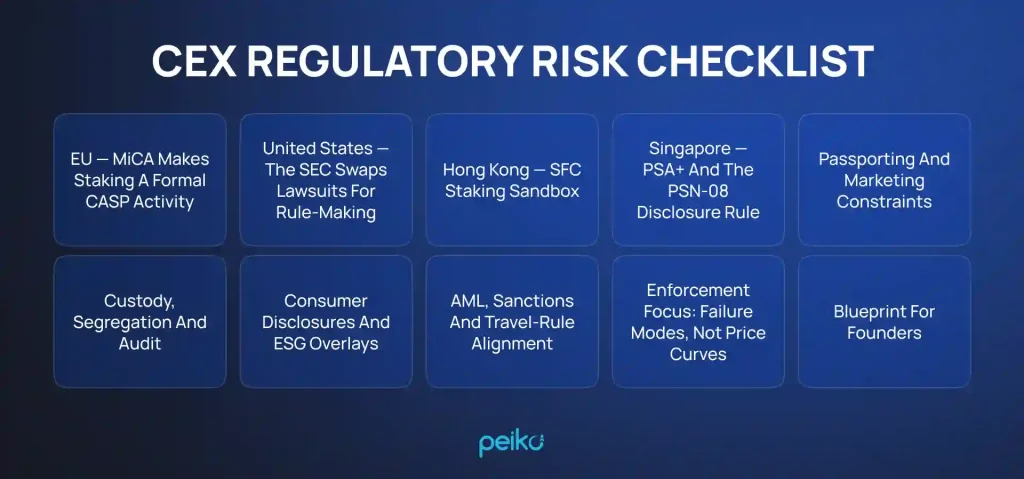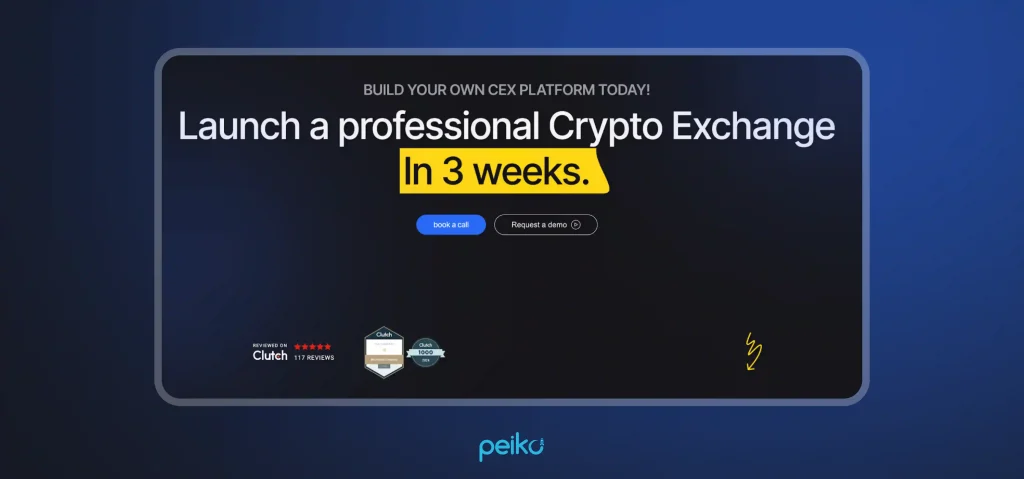In 2025, the rules governing centralized markets’ staking service underwent significant changes. In the same quarter that MiCA’s Delegated Regulations came into effect in the EU, the U.S. SEC (Securities and Exchange Commission) switched from high-profile enforcement to structured rule-making, and more.
Here, we’ll go into detail about how each part of a crypto exchange (CEX) staking stack interacts with the law. We’ll look at how distributed validator modules, multi party custody, and on chain reward accounting work with various rules and tests.
We’ll also touch on why liquidity-token wrappers set prospectus and marketing-permission thresholds, and how to make real time slashing insurance, sanctions screening, and ESG (environmental, social and governance) reporting work in a cross-jurisdictional architecture.
This piece will give you the detailed checklists, decision matrices, model clauses, and risks of staking crypto you need to turn staking from a regulatory liability into a stable income source. If you’re a founder or protocol architect planning a 2025 CEX launch, jump in and make your trade ready for the future before the next guidance drop.
The allure of staking-as-a-service (SaaS) in a 2025 CEX environment
The legal bar for running validators inside a CEX is now just as high as the technical one. Staking is no longer a niche “Earn” tab product. Proof-of-stake (PoS) rewards have grown into a US-$140 billion revenue vertical, roughly 7 % of crypto’s total market cap, and the fastest-growing line item on Tier-1 exchange P&Ls.
Coinbase, for example, booked US-$698 million in subscription-and-services income in Q1 2025—most of it blockchain-rewards commissions—against US-$1.3 billion in trading fees. On Ethereum alone, fully 27 % of all staked ETH (≈5 million ETH) now is with centralized exchanges, giving CEXs a larger validator footprint than any single liquid-staking DAO.
Clear rules erase the gray-area penalty

- Europe (MiCA). The EU’s Delegated Regulations, published 14 March 2025 and in force since 3 April 2025, require CASPs that run validators to keep segregated on-chain reward ledgers and publish daily solvency attestations.
Crucially, they treat staking as a distinct “crypto-asset service” rather than a deposit-taking activity, freeing exchanges from bank-style capital ratios provided the validator keys sit in a DVM (Distributed Validator Module) or MPC (Multi-party computation) set. - United States (SEC). After dismissing its two headline staking lawsuits, the SEC on 29 May 2025 issued a Staff Statement kicking off formal rule-making on “Protocol Staking Activities.” The paper signals that disclosures—not outright prohibition—will be the core compliance burden, and invites comment on a broker-staking exemption akin to ATS rules for dark staking pools.
- Hong Kong (SFC). On 7 April 2025, the SFC (Securities and Futures Commission) unlocked a dedicated staking sandbox. Licensed exchanges can delegate customer assets if slashing risk is insured and a real-time dashboard exposes validator health to clients.
- Singapore (PSA+). MAS (Monetary Authority of Singapore) expanded Payment Services regime—fully live since 4 October 2024—now treats “staking, lending or any form of yield generation on Digital Payment Tokens” as an additional licensable activity. New notices (PSN-08) force CEXs to issue prospectus-style risk fact-sheets before accepting the first stake.
The end effect of the 2025 stake crypto meaning is that entrepreneurs may choose the price of regulatory overhead up front instead of having to roll the Howey dice later.
Economics that play to an exchange’s strengths
| Driver | Why CEXs win | 2025 datapoint |
| Validator unit-economics | Shared custody hardware, 24/7 DevOps desk, and internal MEV (maximal extractable value) mitigation lower per-validator opex below $185 / yr versus $600–$1 200 for a stand-alone node | Binance’s Binance Staked SOL grew to 19.1 % of Solana’s liquid-staking supply by 31 March 2025. |
| Instant liquidity | Order-book or Launchpool campaigns give users T-0 exit, eliminating the 1–21 day unbonding lag that still applies on-chain | WalletConnect Launchpool (Apr 2025) cleared 3-days’ worth of protocol emissions in 18 minutes |
| Cross-sell flywheel | Every staked dollar is “sticky collateral” that feeds margin lending and perpetuals volume; internal risk engines mark staked assets at a haircut rather than full lock-up | Coinbase notes that blockchain rewards are now the single largest driver of recurring subscription revenue |
Institutional-grade risk, institutional-grade yield
- Slashing insurance in real time. Crypto exchanges can pool opt-in fees across thousands of validators and cover double-sign or downtime losses within minutes—something no solo staker can replicate.
- Sanctions & ESG overlays. MiCA’s audit trail plus MAS’ PSN-07 disclosure rules force location-based validator screening and let treasuries report Scope-2 energy intensity per validator.
- Tax neutrality. Hong Kong treats validator income as foreign-sourced for offshore clients. The SEC’s forthcoming form will likely mirror existing 1099-DIV layouts, easing U.S. reporting.
Staking as a service generates long-term revenue while fee compression squeezes spot trading, and investors are pricing protocol-indexed cashflows at six-to-eight times ARR (annual recurring revenue) in exchange M&A (mergers & acquisitions) deals for 2025 CEX launches.
The EU, U.S., and key Asia-Pacific countries now offer explicit licensing playbooks that turn staking from a grey-area hazard into a sanctioned service line, turning regulatory risk into opportunity.
Ethereum and Solana order books illustrate that once one exchange controls even two to three percent of a network’s stake, it becomes the default destination. Validator market share is equally sticky. In summary, incorporating SaaS in your exchange is essential for 2025, and startups that understand the validator, custody, and disclosure stack early will lock in yield streams that can weather the next bear cycle.
Technical considerations: Building robust CEX staking infrastructure
Building a centralized exchange SaaS rail is now an engineering and compliance issue. Launch teams must hard-wire these components before opening deposits in 2025.
Distribution-validator technology (DVT) is the new uptime standard
DVT distributes signing chores to 4-of-7 or 6-of-10 independent nodes in distinct data centers or cloud regions instead than one monolithic validator per address. The approach prevents single-machine failures and reduces slash-risk by two-thirds in big field tests.
Production-grade toolkits arrived this year: SSV (secret shared validator) Network released “SSV 2.0” on 20 May 2025, adding builder APIs to allow exchanges spin up DVT clusters in minutes. Lido’s SSV-powered module enters Holesky testnet in Q2.
Key management: MPC+FIPS-ready HSM > multisig
Current custodians don’t assemble validators’ private keys anywhere. MPC shards the key and signs in safe enclaves, making a compromised shard useless to an attacker. Fireblocks’ Wallet-as-a-Service and Coinbase Institutional expose FIPS 140-3 and SOC 2 gRPC signing endpoints, giving exchanges hardware-grade security without slowing hot wallets.
Separate reward ledgers and real-time solvency proofs
Since 3 April 2025, MiCA’s Delegated Regulations require CASPs (crypto-asset service providers) that operate validators to maintain an on-chain sub-ledger for each customer cohort and post daily solvency attestations. Real-time ledger reconciliation of staked principal, un-distributed protocol incentives, and exchange commission is required. That implies:
- Merkle-tree snapshots at midnight UTC
- Publicly keyed “proof-of-stake-reserves” API for each validator address
- Auditor-signable ESMA (European Securities and Markets Authority) supervisor CSVs (Comma-Separated Values)
Slash risk is now insurable and expected by authorities
Indemnity staking pools are allowed because the SEC’s 29 May 2025 staff statement classifies “slashing coverage” as a non-managerial service. Nexus Mutual’s ETH Slashing Cover creates on-chain policies that settle within 72 hours of double-sign or protracted downtime events. Bitcoin-restaking and Solana will soon have comparable umbrellas.
MEV-aware block construction safeguards yield and optics
No Maximal-Extractable-Value policy for validators is reputational suicide. More than 90% of Ethereum validators relay blocks using mev-boost in 2025, decoupling block-building and clear auctioning bundles. Exchanges mirror flow behind their firewalls:
- Inbound orderflow → internal builder (pre-trade compliance);
- Bid into trusted relays (Flashbots, UltraSound, Agnostic) with censor-list filters;
- Accept the best block, sign using the MPC quorum.
Withdrawal pipes and liquid wraps
Unbonding delays still annoy users. A native liquid-staking token (LST) or voucher tracks the stake and trades in the spot order book. If the exchange market floors the peg, well-designed LSTs keep peg variations within 25 bp even in stress tests, according to 2025 academic research.
ESG data + sanctions for cross-border compliance
- Geofencing validator – IPs and execution clients is required for sanctions screening; Northstake provides OFAC (Office of Foreign Assets Control) compliant node hosting.
- ESG metrics – Article 66(5) MiCA requires CASPs to report asset energy and carbon intensity. Most exchanges wire Grafana dashboards directly into validator telemetry to generate watt-hour per epoch numbers on demand.
2025 launch-team checklist
| Component | Good enough in 2023 | Required in 2025 |
| Validator orchestration | Single VPS (Virtual Private Server) | DVT cluster across ≥3 jurisdictions |
| Key custody | Cold-hot multisig | MPC-Hardware Security Module hybrid with quorum controls |
| Rewards accounting | Internal database | On-chain Merkle ledger + daily PoSR |
| Slash mitigation | Manual restarts | Auto-failover + insured cover note |
| MEV policy | None / private | MEV-boost with public relay stats |
| Liquidity | Forced unbonding | Exchange-native LST (Liquid Staking Token) with deep book |
| Compliance | KYC/AML (Know Your Customer) | OFAC geofence + ESG energy disclosure |
If you want to stake on CEX in 2025, stream solvency and carbon data in real time, make each module an API-first microservice, and lock validator keys behind MPC quorum. This will make staking less of a legal headache and more of a defendable haven.
Legal & regulatory considerations: Checklist to consider
If you want to launch staking-as-a-service from inside a CEX, we prepared a regulatory risk checklist for you. You can make validator income and embrace all the benefits of staking crypto, but only if you separate your assets, make every moving part public, and insure the things you can’t control.

1. EU — MiCA makes staking a formal CASP activity
A CEX that “participates in or facilitates validation” must apply for the new staking service licence tier, maintain an on-chain sub-ledger for each client cohort, and publish a daily proof-of-stake-reserves attestation since 3 April 2025. The 14 March delegated acts explain that if keys are in an MPC or DVT quorum, the firm is not deposit-taking and exempt from CRR-style capital ratios.
2. United States — the SEC swaps lawsuits for rule-making
The Division of Corporation Finance’s 29 May 2025 Staff Statement classifies “protocol staking activities” as administrative or ministerial, therefore pure validation does not require Securities Act registration. An exchange that decides “whether, when and how much” of a customer’s assets to stake must file Form SPK (Staking Provider Key), follow ATS (Alternative Trading System) broker-staking standards, and provide quarterly slashing-risk statements.
3. Hong Kong — SFC staking sandbox
Licensees can delegate user tokens in a closed sandbox from 7 April 2025 if they buy real-time slashing insurance and publish validator uptime and MEV information on a public dashboard. Early adopters get seasoning credit when the activity moves to the permanent rulebook from the sandbox.
4. Singapore — PSA+ and the PSN-08 disclosure rule
MAS’ extended Payment Services framework, beginning 4 October 2024, licenses “any form of yield generation on Digital Payment Tokens”. Notice PSN-08 requires exchanges to provide prospectus-style fact sheets before accepting the initial stake, explaining cutting, unbonding, and tax staking risks.
5. Passporting and marketing constraints
Cross-border marketing must follow each state’s retail-investor and sustainable-finance labelling laws, however, MiCA staking licenses can be passed throughout the European economic area. Interstate marketing is allowed in the U.S. after Form SPK is implemented, although blue-sky regulations apply if promotional literature specifies expected APY (Annual Percentage Yield).
Only “qualified investors” can advertise in Hong Kong and Singapore unless the product has a capital-preservation floor or insurance wrap.
6. Custody, segregation and audit
Insolvency-remote segregation is the common thread across all major blocs: client stake and unredeemed incentives live in an on-chain Merkle ledger, while exchange commission flows into a different address. Investors now demand daily evidence of solvency (MiCA), periodic SOC-2 reports (SEC), and trustee attestations (SFC) in due-diligence war rooms.
7. Consumer disclosures and ESG overlays
Slashing likelihood, validator energy intensity, and wrapper token liquidity must be covered in a one-page Key Staking Information Document under PSN-08 and MiCA Article 66(5). Live validator telemetry from many exchanges is used in Grafana dashboards to convert watt-hours-per-epoch into kg-CO₂-equivalent for SFDR (Sustainable Finance Disclosure Regulation) and TCFD (Task Force on Climate-related Financial Disclosures) reporting.
8. AML, sanctions and travel-rule alignment
FATF Rec 16 and EU Funds-Transfer Regulation require name-tagging stake inflows and outflows above €1,000. Hong Kong’s sandbox incorporates OFAC screening for validator IPs, relay endpoints, and MEV builder connections into its real-time dashboard template.
9. Enforcement focus: failure modes, not price curves
From token prices to missed attestations, downtime, double-signs, and unhedged ETH-MATIC conversions, regulators are focusing on operational errors. The SEC Staff Statement identifies cutting insurance as a non-managerial supplementary service, suggesting fraud charges for unreported losses. In Hong Kong’s sandbox, two downtime events within 30 days halt new-customer onboarding.
10. Blueprint for founders
Have one lawyer handle licensing, cross-border marketing, and ongoing disclosures; set up a Merkle-proof service that posts to IPFS every midnight; pre-contract an insurance wrapper covering at least 0.5% of staked value; and pipe validator telemetry to an OFAC filter and an ESG calculator. Tackle those boxes and your staking line goes from “grey-area headache” to a passportable, bank-auditable revenue stream regulators and investors recognize.
Challenges & staking risks for CEXs and users
Staking on a CEX can become a self-funding moat. However, it’s only possible if operators treat validator operations like critical national infrastructure and clearly communicate all possible failure modes to users in plain language. The Peiko team prepared the necessary things to pay attention to:
1. Operational & slashing risk
- Downtime or double-signs still burn capital instantly. The SEC’s March-2025 technical briefing with Coinbase reports “principal-level” loss when a validator is cut, even though network-wide slashing stays below 0.04 % of stake.
- Attack surface widens with scale. A Lido Chorus One notable breach in May 2025 disclosed 25% of staked ETH, indicating that multi-operator crypto staking pool is vulnerable.
- Insurance helps but is finite. While new policies like Chainproof’s CESR-backed policy payout within 72 hours, capacity is limited to ≈$200 m, compared to the $90 b staked on Ethereum.
2. Custody & cybersecurity risk
- CEX hot-wallets remain a honeypot. Two weeks ago, Coinbase’s service staff experienced insider-enabled data theft, proving that credential custodial CEXs leakage can lead to social-engineering loss.
- External hacks are frequent and global. OSL reported repeated eight-figure CEX losses in Q1-2025, while SpringerLink found nine exchange breaches on four continents in the past year.
- User downside is asymmetric. Customers are unsecured creditors if an exchange collapses; most platforms lack crime insurance like banks.
3. Liquidity & price-tracking risk
- Liquid-staking tokens can de-peg. Stress studies by CoinMetrics show that LSTs can drift by 120 bp when exit queues swell, erasing 25% of a year’s protocol yield.
- Redemption halts cascade into wider markets. A single validator fault can freeze the LST order book and propagate peg pressure to DeFi staking pools that accept the token as collateral by pausing CEX withdrawals.
4. Regulatory, sanctions & ESG overhang
- Rules keep shifting mid-game. MiCA’s Article 66(5) requires real-time carbon-intensity disclosure, and MAS PSN-08 requires prospectus-style fact-sheets before the first stake is taken, strict timeframes that surprised several Asian exchanges.
- Geofencing is compulsory. The 2025 OFAC enforcement roll-up increases crypto-related penalties; validators and MEV relays must be IP-screened in real time or face strict-liability fines.
- Tax leakage crosses borders. CEXs must operate parallel withholding logics for U.S., EU, and Hong Kong clients due to validator income conflicting with user domicile restrictions.
5. Market conduct & concentration risk
- Internal desks can trade against customers. In-house desks can trade against customers. Most major CEXs (except Coinbase) maintain proprietary books that can “stop-loss hunt” retail holdings, according to a May-30 exposé.
- Automation glitches move markets. The April-2025 BitGet VOXEL bot fire caused $12.7 b in phantom volume and showed that a single malfunctioning algo can disrupt everlasting markets.
- Validator share is consolidating. Should a top-three CEX go dark, chain liveness becomes a systemic issue. Coinbase holds 11.4% of staked ETH.
Operating a staking line within a centralized exchange remains a precarious balancing act, despite the improved rulebooks and production-grade gear available in 2025. There are five main categories of problems, and the blast-radius (maximum impact zone) for the exchange and the end-user varies for each.
Vendor spotlight – Peiko’s white-label staking stack
Peiko’s white-label staking services crypto is a true SaaS overlay: every core function—matching engine, staking orchestrator, custody bridge, KYC module—runs as an independent micro-service callable over REST or gRPC.
That means a founder can bolt Peiko’s staking services engine onto an existing exchange front-end, or spin up the full vertical (spot + staking + admin) in Azure, AWS or GCP with Terraform scripts the company delivers out of the box.

Compliance baked in:
- KYC/AML. SumSub handles identity, while Travel-Rule data tags ride the same message bus used for deposits and withdrawals.
- OFAC & ESG dashboards. A built-in Grafana stack geofences validator IPs in real time and converts telemetry into watt-hours-per-epoch so Article 66(5) and PSN-08 disclosures are one click away.
- Slashing insurance hook. The staking service can auto-route 3–5 bp of commission to Nexus Mutual or Chainproof and surface cover capacity alongside APY in the client UI.

Commercial model that mirrors SaaS economics
Among staking providers, Peiko licenses the code base once, then charges no revenue share on staking yield. That lets an exchange keep 100 % of its validator commission, turning the platform fee into a cap-ex line amortised over the first few months of operation.
When a white-label beats a green-field build
| Decision factor | DIY build | Peiko white-label |
| Launch timing | 8–14 months typical | ≤ 3 weeks end-to-end |
| Regulatory artefacts | In-house legal drafts | Pre-templated MiCA PoSR, Form SPK, PSN-08 kits |
| Up-front cost | US $450 k – $1 million | US $95 k flat |
| Custody grade | Team must integrate Fireblocks, MPC, audits | Fireblocks + MPC already wired |
| Future scaling | Rewrite for micro-service | Native autoscaling on Kubernetes |
Just like you can rent Stripe for payments, you can rent the most difficult parts of SaaS using Peiko’s white-label solution.
Conclusion
In summary, either you build the stack yourself or license it from a specialist like Peiko, the winning formula is DVT for liveness, MPC-backed custody for key security, on-chain Merkle ledgers for MiCA/SEC transparency, real-time ESG and sanctions telemetry, and a pre-funded slashing-insurance sleeve regulators can check off in one line.
Founders who lock in these basic features now will capture most of the validator revenue before it disappears. They will also have a compliance record that is on par with the current policymakers, which will make staking return the new base rate for long-term, subscription-grade exchange income.
From the first day with Peiko crypto staking services, your team gets a fleet of validators processing DVT, MPC custody, solvency proofs, sanctions filters, and ESG telemetry. Contact us and get the freedom to compete for market share until the next rule change comes into effect.
FAQ
Stake crypto meaning lies in putting your digital assets in a POS blockchain to make sure transactions are true, keep the network safe, and get rewards. You can think of staking in crypto as earning interest on crypto deposits. Cryptographic incentives and decentralization make this possible.
In staking cryptocurrency, validators run nodes to group and check transactions. By using tokens as collateral, they make sure people are honest and get native-token rewards based on the amount they risk. The validator suite from Peiko company helps skilled operators get the most uptime and yield.
Even though yields can be tempting, staking in crypto comes with fines for bad behavior, lock-up illiquidity, downtime, and protocol exploits. The Peiko business lowers its risk by monitoring in real time, but it is still very important to do a lot of research on the code and the way it is run.
You can go to events in the crypto staking field (like ETHDenver), join forums for validators (like ValidatorNetwork), or hire specialized consulting companies. The advice desk at Peiko offers customized help for planning and checking high-performance staking operations.









